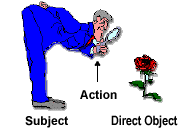Whenever one acts upon something or someone, verbs with a direct object are used. These verbs include "eat," "watch," "listen," etc.
|
For instance, "hamburger" as in "John eats a hamburger at McDonald's everyday" is the direct object of the verb "eat." A direct object is something (or someone) that someone (or something) acts upon.
A direct object is marked by the particle を in Japanese. (FYI: The hiragana を is used only as a grammatical particle.) |
|||||||||
| In Japanese, when referring to when X acts upon a direct object, you can start with X + は (or が), followed by the time + に, followed by the location of activity + で, and then say the direct object and mark it with particle を. Finally, add the appropriate verb のみます, たべます, and so on to complete the sentence.
|
||||||||||
Topic は
Here's an example. To say "Lisa eats lunch at McDonald's at 1 o'clock," you can start with the subject ("Lisa") and mark it with は (or が).
|
Topic は timeに
Then you say the time 1じ followed by the particle に.
 |
Topic は timeにloc. of activityで
Then you say the location of activity followed
by the particle で.
|
Topic は timeにloc. of activityで
direct objectを
Now, say what she eats
(ひるごはん)
and mark it with the direct object marker を.
|
Topic は timeにloc. of activityで direct objectを
たべます
Finally, say the verb たべます to complete the sentence.
|
| Question words can be substituted for any part of speech before the verb.
 |
We have introduced general verb sentences in Japanese with three different types of verbs (verbs that do not take a direct object (e.g., おきます), verbs with a destination (e.g., いきます) and verbs that take a direct object (e.g., たべます). The table below represents these verbs. Based on the table, you should be able to make three sentences. Click the Play buttons below to hear the answers. Other parts of speech not listed below include personと ("with a person"), means/toolsで ("by means of/with""), frequency of activities ("always/usually/often/etc.") and length of time of activities ~じかんぐらい. Examples of these additional parts of speech will be shown later.
As always, you can scramble parts of speech before the verb, so the order is not important. It's the particles that determine the meaning --- who does what, where, when, etc. |











